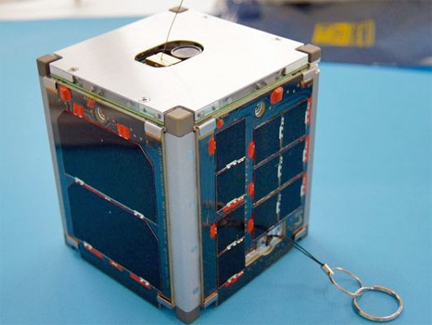[SatNews] South Africa's first nano-satellite experienced two very close encounters with defunct satellites in the past few days, after three months in orbit, authorities said on Monday.

South Africa's ZACUBE-1 nanosatellite.
The nano-satellite, the ZACUBE-1, came within an estimated 185m of the defunct Russian COSMOS 2151 satellite over Antarctica on Wednesday, the South African Department of Science and Technology (SADST) said in a statement. Remarkably, a second warning was received on Thursday, with ZACUBE-1 predicted to come within 85m of yet another defunct Russian satellite, METEOR 2-5, over Brazil.
ZACUBE-1 was developed by the Cape Peninsula University of Technology (CPUT) and launched on November 21, 2013. The CPUT has independently confirmed with its ground station that ZACUBE-1 is still beaconing and has survived both close encounters. There is nothing that can be done to alter the course or altitude of ZACUBE-1, as it has no propulsion control, the SADST said, adding that the other two defunct satellites can also not be maneuvered. There is a margin of uncertainty in the predicted paths of the satellites, and all close encounters of this nature can result in collision.
Accidental collisions of space objects are, however, extremely rare, with only two incidents reported since the beginning of space exploration. The risk of collision increases with the number of objects launched, which necessitates technical and regulatory measures to mitigate space debris for the future sustainable use of outer space.
ZACUBE-1 has proven to be a true survivor, and continues to defy the odds in a very harsh environment to carry its scientific mission forward. In its short existence, the satellite survived the ferocity of the launch on a converted inter-continental ballistic missile, harsh radiation from the sun, extreme temperature fluctuations and the recent close calls with space debris. The nano-satellite has been commissioned and all systems are functioning normally. The first satellite beacon was received only hours after launch, and it has been beaconing ever since. The satellite measures only 10 x 10 x 10 cm and weighs 1.2kg, 100 times smaller than Sputnik 1, the first satellite launched into space in 1957. Running on the same amount of power as a 5 watt bulb, ZACUBE-1 carries a high frequency beacon that will be used to study the propagation of radio waves through the ionosphere, providing valuable space weather data to the South African National Space Agency as it orbits Earth up to 15 times a day at an altitude of 600km. (Source: Xinhua)

